
 | 
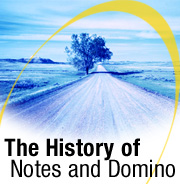


Level: All
Works with: Notes/Domino
Updated: 09/29/2003

Inside this article:
Development of Notes begins
Release 1.0
Release 2.0
Release 3.0
Release 4.0
Release 4.5
Release 5.0
Notes/Domino 6
Notes/Domino 6.5 and beyond

Related links:
Milestones in Notes/Domino security
Notes 6 Technical Overview
Domino 6 Technical Overview
Domino Designer 6 Technical Overview

Get the PDF:
 (354 KB) (354 KB)


| 
 | 
As you might expect of such complex and successful software, Lotus Notes and Domino share a long and rich history. In some respects, this history mirrors the evolution of the computing industry itself—the development and widespread adoption of PCs, networks, graphical user interfaces, communication and collaboration software, and the Web. Notes and Domino have been there nearly every step of the way, influencing (and being influenced by) all these critical developments.
This article briefly retraces the history of Notes and Domino, starting with the earliest conceptual and development stages and continuing through major feature releases. Along the way, it examines:
- Where the idea of Notes originated
- Notes pre-release development
- Release 1.0
- Release 2.0
- Release 3.0
- Release 4.0 and 4.5
- Release 5.0
- Notes/Domino 6
Finally, we'll take a quick look at Notes and Domino 6.5, the upcoming new version, and talk a little about what the future holds for these storied products.
The early days: The birth of an idea
You may find this a little surprising, but the original concept that eventually led to the Notes client and Domino server actually pre-dates the commercial development of the personal computer by nearly a decade. Notes and Domino find their roots in some of the first computer programs written at the Computer-based Education Research Laboratory (CERL) at the University of Illinois. In 1973, CERL released a product called PLATO Notes. At that time, the sole function of PLATO Notes was to tag a bug report with the user's ID and the date and to make the file secure so that other users couldn't delete it. The system staff could then respond to the problem report at the bottom of the screen. This kind of secure communication between users was the basis of PLATO Notes.
In 1976, PLATO Group Notes was released. Group Notes took the original concept of PLATO Notes and expanded on it by allowing users to:
- Create private notes files organized by subject
- Create access lists
- Read all notes and responses written since a certain date
- Create anonymous notes
- Create director message flags
- Mark comments in a document
- Link notes files with other PLATO systems
- Use multiplayer games
PLATO Group Notes became popular and remained so into the 1980s. However, after the introduction of the IBM PC and MS-DOS by Microsoft in 1982, the mainframe-based architecture of PLATO became less cost-effective. Group Notes began to metamorphose into many other "notes type" software products.
Ray Ozzie, Tim Halvorsen, and Len Kawell worked on the PLATO system at CERL in the late 1970s. All were impressed with its real-time communication. Halvorsen and Kawell later took what they learned at CERL and created a PLATO Notes-like product at Digital Equipment Corporation.
At the same time, Ray Ozzie worked independently on a proposal for developing a PC-based Notes product. At first, he was unable to obtain funding for his idea. However, Mitch Kapor, founder of Lotus Development Corporation, saw potential in Ozzie's work and decided to invest Lotus's money for its development. Kapor's business acumen, creativity, and foresight were critical in changing Ozzie's vision into reality.
Development on Notes begins
Near the end of 1984, Ozzie founded Iris Associates Inc., under contract and funded by Lotus, to develop the first release of Lotus Notes. In January 1985, shortly after Iris Associates began, Tim Halvorsen and Len Kawell joined Ozzie, followed soon after by Steven Beckhardt. All brought extensive knowledge and vision to the company, as well as career-long interests in collaboration and messaging software at a time when such concepts were considered novel at best and impractical at worst. They modeled Lotus Notes after PLATO Notes, but expanded it to include many more powerful features. Alan Eldridge from Digital Equipment Corporation soon joined Iris Associates, contributing to the database and security features of the Notes architecture.
The original vision of Notes included on-line discussion, email, phone books, and document databases. However, the state of the technology at the time presented two serious challenges. First, networking was rudimentary and slow compared to today. Therefore, the developers originally decided to position Notes as a personal information manager (PIM), like Organizer, with some sharing capability. Second, PC operating systems were immature, so Iris had to write a lot of system-level code to develop things such as the Name Server and databases. Eventually, as networking became more capable, Iris began to speak of Notes as groupware. The term groupware (which eventually grew virtually synonymous with Notes itself) refers to applications that enhance communication, collaboration, and coordination among groups of people.
To meet these goals, Notes offered users a client/server architecture that featured PCs connected to a local area network (LAN). A group could set up a dedicated server machine (a PC) that communicated with other groups' server machines (either on the same LAN or through switched networks). Servers exchanged information through "replicated data" (that is, there were potentially many copies of the same database resident on different servers, and the Notes server software continuously synchronized them). This made it just as easy for users to exchange information with co-workers in a branch office as with those in their own office.
The vision of the founders quickly evolved into the idea of creating the first virtual community. Tom Diaz, former Vice President of Engineering at Iris, said, "It was eccentric to think about group communication software in 1984, when most people had never touched an email system...the product was very far ahead of its time. It was the first commercial client/server product."
Another Notes key feature was customization. According to Tim Halvorsen, early on there was debate over the structure of Notes. He said the developers wondered, "Should we build applications in the product or should we allow it to be flexible and let users do it because we don't know what they will want?" They eventually opted for a flexible product that allowed users to build the applications they needed. Thus, Notes architecture used a building block approach; you could construct group textual applications by piecing together the various services that are available. "This was big in the success of the product," stated Halvorsen. "In no case do we say, 'no, this is the only way you can do it.'" Notes has survived the changes in the industry because it is a flexible product users can customize to fit their changing needs.
Around this time, Apple Computer released the Macintosh with a new easy-to-use graphical user interface. This influenced the developers of Lotus Notes, and they gave their new product a character-oriented graphical user interface.
Most of the core development was completed within two years, but the developers spent an additional year porting the code for the client and the server from the Windows operating system to OS/2. During this time, the developers at Iris used Notes to communicate remotely with people at Lotus. Halvorsen said, "Simply using the product every day helped us develop key functionality." For example, the developers needed to synchronize data between the two different locations, so they invented replication. "This wasn't in the original plan, but the problem arose and we solved it," said Halvorsen.
The development of Notes took a long time by today's standards. But according to Steve Beckhardt, this extended development period helped ensure the success of Notes. This made Notes a very solid product with no real competition in the market.
In August 1986, the product was complete to a point it demonstrated all of its unique capabilities and had preliminary documentation. It was ready to ship to the first internal Lotus users. At that time, Lotus evaluated and accepted the product. Lotus bought the rights to Notes in 1987.
Lotus Notes was successful even before its first release. The head of Price Waterhouse viewed a pre-release demo of Notes and was so impressed he bought 10,000 copies. At that time, it was the largest PC sale ever of a single software product. As the first large Notes customer, Price Waterhouse predicted that Lotus Notes would transform the way we do business. As we now know, they were right.
Release 1.0: A star is born
The first release of Notes shipped in 1989. During the first year it was on the market, more than 35,000 copies of Notes were sold. The Notes client required DOS 3.1 or OS/2. The Notes server required either DOS 3.1, 4.0, or OS/2.
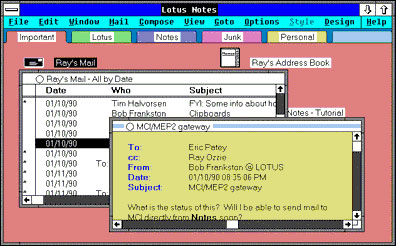
Release 1.0 provided several "ready to use" applications such as Group Mail, Group Discussion, and Group Phone Book. Notes also provided templates that assisted you in the construction of custom applications. This ability to design customizable applications using Notes led to a business partner community that designed Notes applications. Today, thousands of companies build their own software products that run on top of Notes, but the founders didn't expect Notes to be a "developers' product." They envisioned a shrink-wrapped PC communications product that would run right out of the box. In reality it became both.
Release 1.0 offered the following functionality, much of it revolutionary in 1989:
- Encryption, signing, and authentication using the RSA public-key technology, which allows you to mark a document in such a way that the recipient of the document can decisively determine that the document was unmodified during transmission. Notes was the first important commercial product to use RSA cryptography, and from that point on, users considered security as a prime feature of Notes.
- Dial-up functionality, including the ability to use the dial-up driver for interactive server access, the ability to allow users to specify modem strings, support for operator-assisted calling, and automatic logging of phone call activity and statistics.
- Import/export capability, including Lotus Freelance Graphics metafile import, structured ASCII export, and Lotus 1-2-3/Symphony worksheet export.
- Ability to set up new users easily, including allowing system/server administrators to create a user mailbox, to create a user record in the Name and Address database, and to notarize the user's ID file through dialog boxes. You can also automatically create a user's private Name and Address database, in case that user wants to use private distribution lists.
- An electronic mail system that allows you to send mail without having to open your private mail file, to receive return receipts, to be notified when new mail arrives, and to automatically correct ambiguous or misspelled names when creating a mail message.
- On-line help, a feature not offered in many products at this time.
- Inclusion of the formula language, making the programming of Notes applications easier.
- DocLinks providing "hotlink" access between Notes documents.
- Keyword (checkbox and radio button) features.
- Access Control Lists (ACLs) determining who can access each database and to what extent.
- Ability to administer remote replicas of databases from a central place, if the database manager desired that behavior. You can replicate ACLs as an entire list, not just individual entries, to remote copies of the database.
Release 1.1
The first set of enhancements to Notes became available in 1990. Release 1.1 was not a feature release, but an internal restructuring of the code that included new portability layers. The developers made a large architectural investment in Notes as a multi-platform product. They wrote a large amount of the product insulating the functional parts of Notes from the operating system. This means that, although Notes ran on many platforms, the developers didn't port the code from platform to platform. They developed the code for different operating systems in parallel. Already, this investment began to pay off. In this release of Notes, they supported additional operating systems: OS/2 1.2 Extended Edition, Novell Netware Requester for OS/2 1.2, and Novell Netware/386. However, their biggest achievement and the focus of this release was the added support for Windows 3.0, which was achieved by working closely with Microsoft as an influential Beta site for Windows 3.0.
Release 2.0: Bigger and better
The next major release of Notes shipped in 1991. For Release 2.0, scalability became the focus. After Release 1.0 sold to large companies, Iris realized Notes needed to scale to support 10,000 users. Notes was initially intended for small- to medium-sized businesses. The founders' original vision did not include large companies as users; they only expected 25 or so people logging in to one server. The reason for this was that the PCs of the day didn't have a lot of power. As the PCs and their networks became more powerful, so did Notes.
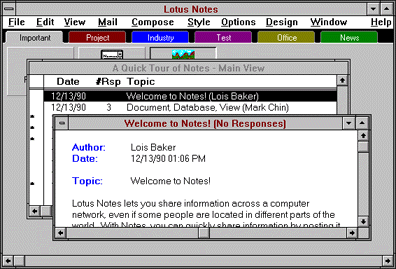
Throughout the 1990s, as Notes accommodated more and more users, larger companies bought it. Sales growth was slow but steady as Lotus sold the product to high-end customers willing to invest time and effort getting large groups of users up and running. As these early customers used Notes with great success, the installed user-base grew.
Originally, there was a 200-license minimum for Notes; Lotus did not sell individual copies. As a result, the minimum purchase price was $62,000. Lotus targeted big companies because they felt that only those companies would comprehend and exploit the potential of the product. Price Waterhouse and other early test sites showed that the big companies got it.
Tim Halvorsen remembers that as Notes slowly began to grow, so did the development team. By the second release, there were approximately 12 developers working on Notes. For the early releases, Halvorsen said, "We were very responsive to the needs of our customers, but then we also tried to build it with the ability to accommodate future changes in the industry."
Release 2.0 included the following enhancements:
- C Applications Programming Interface (API)
- Column totals in views
- Tables and paragraph styles
- Rich text support
- Additional formula language @functions
- Address look-up in mail
- Multiple Name and Address books
- Return receipt for mail memos
- Forwarding documents via mail
- Larger databases and desktop files
Release 3.0: Notes for everyone
Notes Release 3.0 shipped in May 1993. By this time, Iris had about 25 developers working on Notes. Release 3.0 was build number 114.3c. This means that it was the 114th successful build of Notes ever and that it took three tries to complete the final build.
At the time of the release, more than 2,000 companies and nearly 500,000 people used Notes. The goal of Release 3.0 was to build further on what Notes already was, to make the user interface cooler and more up-to-date, and to evolve it further as a cross-platform product. Lotus aimed the product at a larger market and reduced the price accordingly. Release 3.0 featured the first of a series of rewrites of the database system, NIF, to make the product scale to even larger user populations. This release was suitable for about 200 users simultaneously using a server.
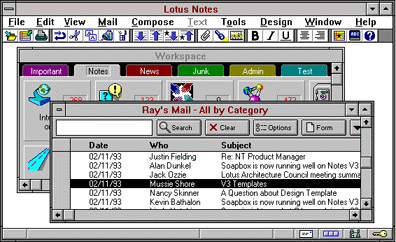
Release 3.0 also added greater design capability and many additional features, including:
- Full-text search
- Hierarchical names, views, forms, and filters
- Additional mobile features, including background replication
- Enhanced scalability
- Alternate mail capability
- Development of common API strategies for cross-platform Notes applications
- Selective replication
- Support for AppleTalk networks
- Deployment and administrative improvements
- Support for the Macintosh client
- A server for the Windows operating system
Lotus SmartSuite shipped in 1993 with a Bonus Pack, called Notes F/X that allowed applications to share data and still integrate the data in a Notes database using OLE.
In May 1994, Lotus purchased Iris Associates, Inc. This had very little effect on the product itself, but it did simplify some of the pricing and packaging issues surrounding Notes. In May 1995, Lotus released InterNotes News, a product that provided a gateway between the Internet news sources and Notes. This was the first project that reflected the growing influence of the Internet on Notes.
Release 4.0: A whole new look
In January 1996, Lotus released Notes Release 4.0. This release offered a completely redesigned user interface based on customer feedback. This interface exposed and simplified many Notes features, making it easier to use, program, and administer. When the developers gave a demonstration of the new user interface at Lotusphere (a yearly user group meeting), they received a standing ovation from the crowd of customers.
The product continued to become more scalable. It became faster and faster as companies added additional processors to multiprocessor servers. Lotus cut the price of Notes in half, and thus successfully gained a larger market share.
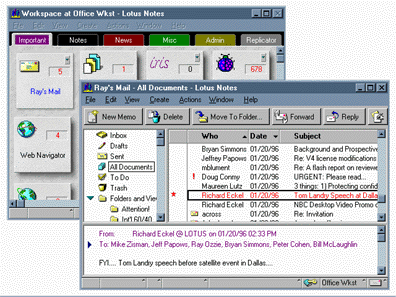
In addition, Notes began to integrate with the Web, and many new features reflected the prominence of Web technology in the industry. Ray Ozzie, the first Notes developer and founder of Iris Associates, saw the importance of the Web before the Web became the phenomenon it is today. This was a key element in the success of Notes. A new product called the Server Web Navigator allowed the Notes server, connected to the Web, to retrieve pages off the Web, and then allowed users to view the pages in a Notes client.
Another product that leveraged the Web was a server "add-in" called the InterNotes Web Publisher. Now users could take a Notes document, convert it to HTML, and display it in a Web browser. The server could statically take Notes documents and publish them to the Web. It was not yet dynamic because there was a time delay involved in this process. The documents went to the file server and were later published to the Web.
Release 4.0 also offered:
- LotusScript, a programming language built into Notes
- A three-paned UI for mail and other applications with document preview ability
- Pass-thru servers
- A new graphical user interface for server administrators
- Built-in Internet integration, including Web browser accessible Notes databases
- Upward mobility, including locations and stacked icons
- An enhanced replicator page
- Rapid application development and programmability as a result of an Integrated Development Environment (IDE), infoboxes, and redesigned templates
- View, folder, and design features, including the ability to create action bars, the ability to create navigators that allow easy graphical navigation among views, and improved table support
- Search features, such as the ability to search a database without indexing it, and the ability to add conditions to a search with the Search Builder without writing a formula
- Security features, such as the ability to keep local databases secure and the ability to restrict who can read selected documents
- Internet server improvements, including SOCKS support, HTTP proxy support, and Notes RPC proxy support
In July 1995, IBM purchased Lotus, primarily to acquire the Notes technology. The buyout impacted Notes in a positive way. Prior to the buyout, the Notes developers felt that they were facing some strategic uncertainty as a result of the growing prominence of the Web and increasing competition in the market. The IBM acquisition provided solid financial backing, access to world class technology, including the HTTP server that became Domino, and an increased sales force. Notes now sold to very large Fortune 500 companies, and it sold to entire corporations instead of just departments. These positive gains gave the developers of Notes the freedom to invest in long-term projects. In 1996, following the release of Notes 4.0, the business and technological competition exploded—for messaging products, for Web servers, and for development systems for these products.
The development of Release 4.0 took more than two years, which in light of the growing competition and the shorter development cycles of competitors using the Web to release products, was now too long. In order to give large enterprises a highly stable Notes system, but also to ensure that Iris Associates would continue its tradition of technical leadership, the developers divided the Notes product line into the following two branches:
- A product line of new feature releases, beginning with Release 4.5, offered first-rate new functionality in the fastest development cycle possible while still maintaining good quality. Market competition and the needs of the software vendors building applications on top of Notes influenced these releases.
- 90-day releases, also called "quarterly maintenance releases," contained few or no new features. Maintenance input from existing Notes customers almost entirely drove this second product line. Many of these customers were the large-enterprise users who heavily stressed the server and were among the first to find deployment-blocking bugs. The sole purpose of these releases was to gather up fixes for bugs, test them in an integrated manner, and make them available to licensed customers. These releases were more conservatively managed than the new feature releases, and they were appropriate for large companies who were more interested in a highly stable release of the product than in pioneering brand new technology. A third digit in the product release number designated maintenance releases, such as the 3 in 4.5.3.
Even today, at any particular time, there are two Notes families (or two "code streams") maintained this way, while a third code stream is underdevelopment for the next feature release.
New users had a choice as to the release of Notes they could buy. Most new users received the current feature release. As time passed, most users began to combine the releases, so that on some machines they took advantage of the new feature release, while other machines ran a maintenance release version. These two releases of the product did merge at certain points in the development process. When coding started for a new feature release, all the code from past releases, including the bug fixes were merged together and a new code stream began. This merging process happened a few times early in the development process of the new feature release. This merging process ensured that the reliability of feature releases was high.
Release 4.5: The Domino theory
Lotus changed the brand name of the Notes 4.5 server product to "Domino 4.5, Powered by Notes" in December 1996 and shipped the Domino 4.5 server and the Notes 4.5 client. Domino transformed the Notes Release 4.0 server into an interactive Web applications server. This server combined the open networking environment of Internet standards and protocols with the powerful application development facilities of Notes. Domino provided businesses and organizations with the ability to rapidly develop a broad range of business solutions for the Internet and for intranets. The Domino server made the ability to publish Notes documents to the Web a dynamic process.
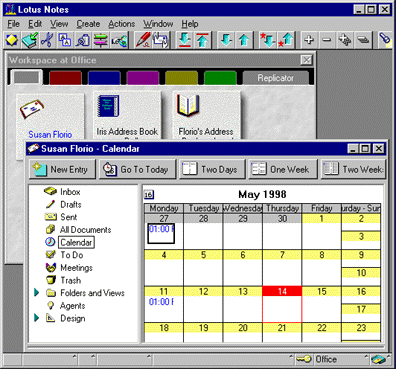
Release 4.5 provided the following improvements:
- Messaging, including native Notes calendar and scheduling, SMTP/MIME support (SMTP MTA), cc:Mail network integration (cc:Mail MTA), POP3 support (on the Notes server), and a Mobile corporate directory
- Internet server, including Domino.Action, and multi-database full-text searching
- Personal Web Navigator, including client-side retrieval of HTML pages over HTTP, Personal Web Navigator database, Java applet execution, Netscape plug-in API support, and HTML 3.2 support
- Scalability and manageability, including Domino server clusters, directory assistance, Administration Process enhancements, new database management tools, Windows NT single logon support, and Notes/NT user management
- Security, including Execution Control Lists and password expiration and reuse
- Programmability, including Script Libraries, OLE2 support on the Macintosh, extended OCX support, LotusScript enhancements, and IDE enhancements
- Enhanced application development capability with support for Java 1.1 agents and Java-based access to Notes objects
- Seamless Web access from the Notes client
- Ability to hide design elements from a Web browser or a Notes client if necessary
Release 5.0: Web integration by design
Notes and Domino Release 5.0 shipped in early 1999 as the 160th build since 1984. The R5 code was a direct descendent of Release 1.0 and parts of its architecture still supported Release 1.0 clients. But, while backwards compatible, R5 was definitely moving into the future.
With R5's continued Web integration, it was no longer a question of Notes versus the Internet—they became inseparable. The new user interface for R5 illustrated this by taking on more browser-type characteristics. R5 also supported more Internet protocols and extended its reach to include access to information stored in enterprise systems as well as Notes databases.
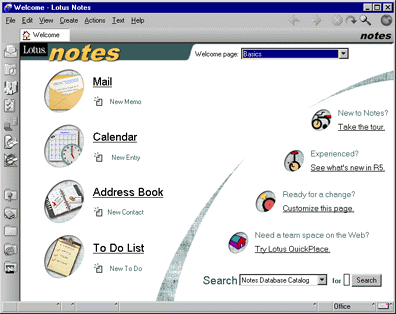
For application developers, Domino Designer, the successor to Lotus Notes Designer for Domino, offered significant enhancements that make development more productive. Domino Designer is an integrated development environment with the tools needed to rapidly build and deploy secure e-business applications.
The new Domino Administrator made Domino network administration easier with a redesigned user registration and new tools for server monitoring and message management. Important enhancements to the Domino server included:
- Internet messaging and directories, including full-fidelity messaging, native MIME and SMTP support, the new Directory Catalog, and LDAP features
- Expanded Web application services, including CORBA-standard distributed objects, Java, JavaScript, Web clusters, and Microsoft Internet Information Server (IIS) HTTP services
- Database improvements, such as transaction logging and a new on-disk structure (ODS)
Release 5.0. was available on Windows NT, Windows 95, Windows 98, OS/2, Netware, and UNIX. This wide availability, combined with its ability to entwine Notes with the Internet, set a new standard for:
- Easy access to all the information that is important to you, be it personal or public
- Server independence because of the ability to use Notes with Domino R5 as well as other Internet-standard servers
- The ability to read and send messages to any Internet mail server without needing to know about Internet standards, thanks to one, consistent interface
- The latest innovations in Internet messaging with native support for all the major Internet standards
On the Notes client-side, R5 provided easy access to all the information that is important to you—whether that information is personal (like your email and calendar) or public (like your favorite Web sites and Internet newsgroups). The Notes client included a new browser-like user interface with a customizable Welcome page for tracking your important daily information. It also included improvements to the applications you use in your daily work, such as mail, calendar and scheduling, Web browsing, and discussions. As interface designer Robby Shaver said when discussing the R5 client, "The number one goal is to just make the client easier."
Notes/Domino 6: Doing things faster, better, and cheaper
When Notes 6 and Domino 6 were introduced in October, 2002, the business world was dominated by talk of lower cost of ownership, increased productivity, and faster deployment and turnaround. This reflected both the direction of business software as well as each corporation's need to perform more efficiently in the face of ever-increasing time and financial pressures. The message from our customers was clear: We need to do more with less, and we need to do it faster.
As usual, Notes and Domino were in the forefront of this trend. The Domino 6 server offered improved installation as well as scalability and performance enhancements designed to streamline maintenance and lower administration overhead. Domino Designer 6 made it easier to create complex applications and to reuse code, reducing development and deployment time. And Notes 6 remained the collaboration tool of choice for tens of millions of users worldwide with enhanced calendar and scheduling as well as other personal productivity improvements.
For example, the Notes 6 default Welcome Page was redesigned to increase ease of use and to make more functionality accessible:
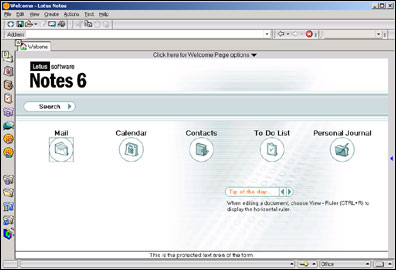
The Notes 6 Welcome Page had many new features, including:
- Welcome Page action buttons, for example, to create a new mail memo or calendar entry
- A preview pane similar to standard Notes databases
- A wizard for customizing and personalizing your Welcome Page
- The Launch Pad for quick access to applications, tasks, and links
- A Tip of the Day about using the Notes client
- Quick Notes interface to create mail, contacts, journal entries, and reminders without having to open the respective databases
One of the more significant Notes 6 enhancements was improved calendar and scheduling, offering new functionality to help manage your time more effectively. For example, the new mini-view, colors, and summary features help to quickly identify the most pressing items. Notes 6 offered multiple options for creating and editing meetings and other calendar entries. Rescheduling could be done primarily through a new point-and-click interface. These and other Notes 6 C&S features are described in detail in the LDD Today article "Saving time with Notes 6 Calendar and Scheduling." And for a complete rundown of new Notes 6 features, see the article "Notes 6 Technical Overview" in the Notes/Domino 6 special issue of LDD Today.
Domino Designer 6 also focused on the trend of doing more with less, offering enhancements in the following areas:
- Reusability features that allow designers to take code written for one application and to reuse it in another.
- Agent design and management with a redesigned agent interface and enhanced agent properties, along with the ability to attach and debug agents running on the server.
- Presentation development, introducing new features that bring the creation and management of new presentation elements, such as layers and style sheets, into the Integrated Design Environment (IDE).
- Managing complex applications with better support both for applications that span multiple databases and that include objects that aren’t traditional elements of an NSF file and for third-party tools for use on the design elements of these applications.
- Database development, making it easier for developers to do the basic work of building an application—from small UI changes to major additions like type-ahead for @functions, HTML in the programmer's pane, the Data Connections resource type, and features to support mobile applications.
These and other Domino Designer 6 features are described in the article "Domino Designer 6 Technical Overview."
But perhaps the most significant enhancements in Notes/Domino 6 were in the Domino server. And as with the Notes client and Domino Designer, our primary theme was helping you work more efficiently. For example, installation and setup offered more options and an improved interface to allow administrators to get servers up and running faster. And we made it easier for an administrator to centrally manage multiple remote servers through features such as policy-based management. Policies help you maintain standard settings and configurations for registration, setup and desktop, archiving, and security. For more information about policy-based management, see the article "Policy-based system administration with Domino 6."
Server scalability and performance was another major issue. To address these needs, Domino 6 introduced features such as network compression, which can reduce the number of bytes sent during transactions by up to 50 percent, and statistics monitoring and analysis to help you plan and run individual systems (as well as your whole domain) more efficiently. In Domino 6, you can monitor performance statistic profiles using charts that display the statistics in real-time or historically. And the Domino Server Monitor includes server profiles that monitor tasks and processes specific to a certain subset of servers.
Of course, security remained an overarching concern for all administrators. Domino 6 boasted new security functionality, such as the new certificate authority, delegated server administration, and improved password management. And you could push Admin ECLs to clients dynamically on an as-needed basis, making it easier to deliver timely updates and to update clients who received the default ECL during setup.
Other new Domino 6 features included:
- Messaging enhancements, including iNotes Web Access and Domino Everyplace servers, extending access to Domino’s messaging infrastructure. And new features for the Web server expanding the capabilities for Web application development and deployment.
- Changes to directories, for example the ability to use LDAP, NameLookup, or both to serve up directories, and a directory indexer task that updates views in the Domino Directory.
- Domino hosting features that allow multiple organizations to be transparently hosted by a single logical Domino server.
- Server cluster enhancements, including making the Cluster Administrator a server thread, adding new settings to control the number of active Cluster Replicators, and adding new Cluster Replicator commands for better control over cluster replication and information gathering.
- Domino Off-Line Services (DOLS) enhancements.
The LDD Today article "Domino 6 Technical Overview" describes these and all other new Domino 6 features.
Looking ahead: Notes/Domino 6.5 and beyond
The development of new features and functionality for Lotus Notes and Domino continues. Notes/Domino 6.5 is now available, offering Notes users enhanced collaboration with tighter integration with Lotus Instant Messaging (Sametime) and improved messaging, particularly with Domino Web Access (formerly iNotes Web Access). This release provides productivity enhancements, such as the new Follow Up feature and the new Unread view in both the Notes and Domino Web Access clients. Domino Designer 6.5 gives application developers the ability to enable a view column and/or Names field to show Instant Messaging on-line status. Also included is the Lotus Domino Toolkit for WebSphere Studio, a set of Eclipse plug-ins you can use to create JavaServer Pages (JSPs) using the Domino Custom Tags. And the Domino 6.5 server supports more platforms, including Windows Server 2003 and Linux on zSeries, and offers additional serviceability and performance improvements. For more on these and all other Notes/Domino 6.5 features, see the article, "New features in Notes/Domino 6.5."
Equally exciting is the development of the next Notes/Domino release already well underway with Beta planned in the not-too-distant future. It's still too early to discuss specific features, but we're working hard to ensure that the next release of Notes/Domino continues in the tradition of its predecessors, offering all the latest functionality, usability, and security our customers have come to expect and demand. | 
 |